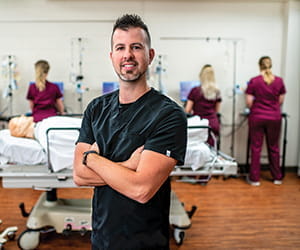Photo by Aggie Brooks.
He recently launched an innovative new nurse orientation model that integrates the hospital’s new nurse orientation with its electronic health record training. Previously, these trainings were conducted independently, but Lee’s model allows new nurse associates to perform related skills and simultaneously document them electronically, simulating the real nursing workflow.
“We have received positive feedback from participants,” Lee says. “The training helped decrease their anxiety about starting their new jobs because they were able to troubleshoot issues before entering their units.”
Here, Lee gives tips on how employees in any industry can identify opportunities for improvement in work processes and support a smooth implementation.
1. ASSESS YOUR AUDIENCE’S NEEDS. “Instead of assuming what people want, take the time to identify your target audience and speak to them personally about what they hope to achieve in their roles. Get to know them, ask what works and what doesn’t, and don’t assume that what you’ve always done at your organization will continue to have the same results. It’s also important to keep up with current trends in the workplace so that you can offer helpful suggestions. Things change all the time, and in order to keep people productive and engaged, you have to stay informed.”
2. UTILIZE COMMUNICATION TOOLS. “When I began my role in 2016, one of my first goals was revamping our education department’s Facebook page to support better internal communication with our nurses. We have since increased our following from 600 people to nearly 1,500. Social media can be a great tool for engaging with your associates while at the same time communicating important education items, especially with younger generations who are accustomed to communicating on these platforms. I also improved the monthly nursing news publication to keep everyone informed about current happenings in our health system.”
3. EMPLOY EVIDENCE-BASED RESEARCH. “At CHRISTUS Trinity Mother Frances Health System, we use the term ‘evidence-based practice’ to describe how we conduct our business. You can’t successfully implement change if you don’t support your findings with solid research and predicted outcomes. Before beginning the new nurse orientation model, we studied multiple professional nursing journals and analyzed how other hospitals conduct their onboarding processes to determine what would work best for us. This research will also come in handy when you present your ideas to leadership. They will be more willing to approve your ideas if they know you are adequately prepared for an efficient implementation with improved outcomes.”




